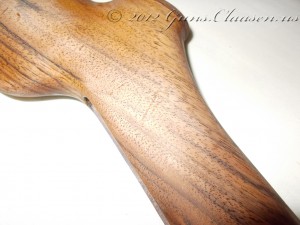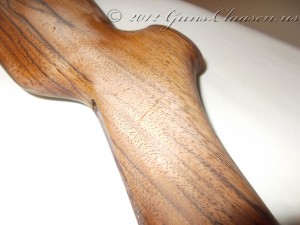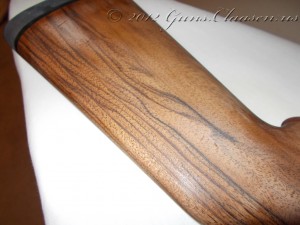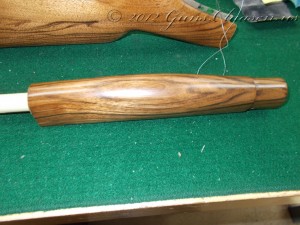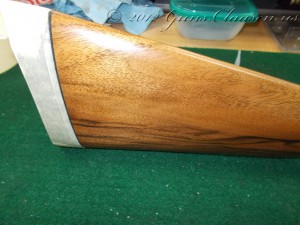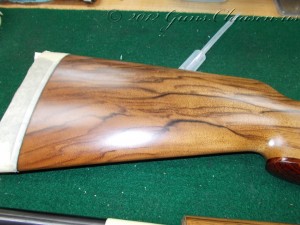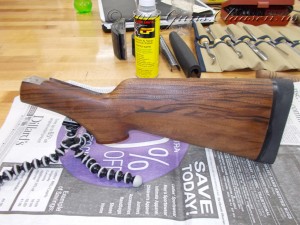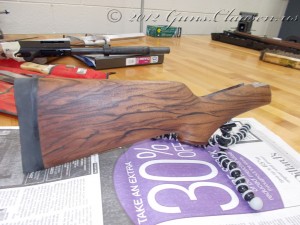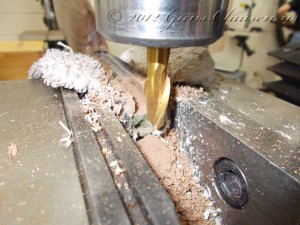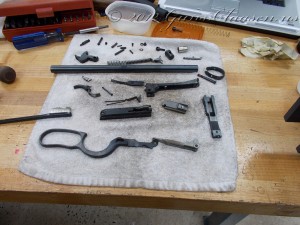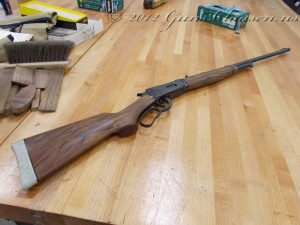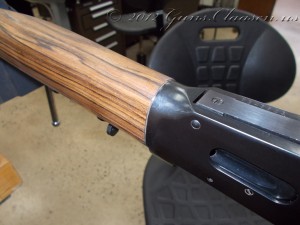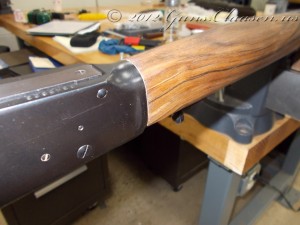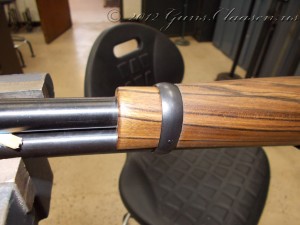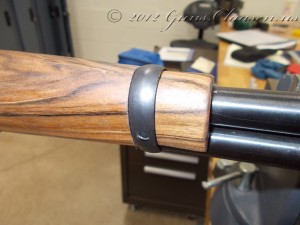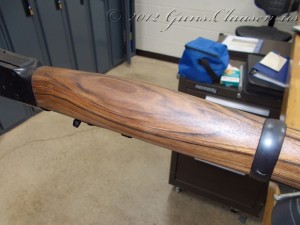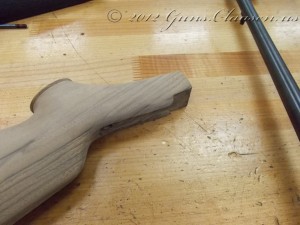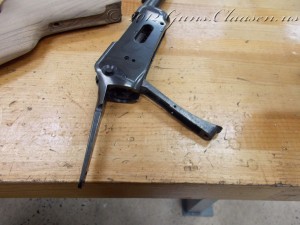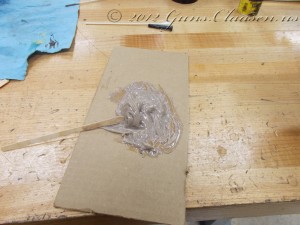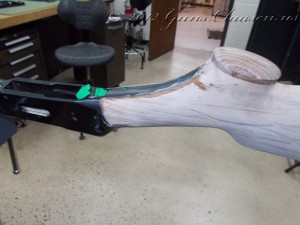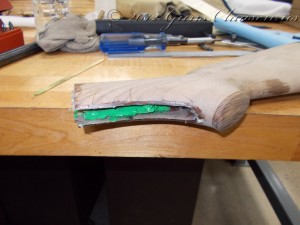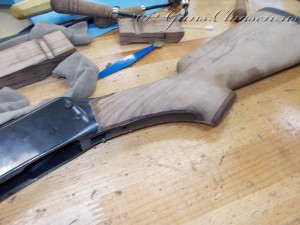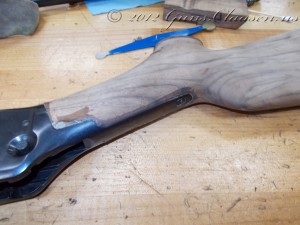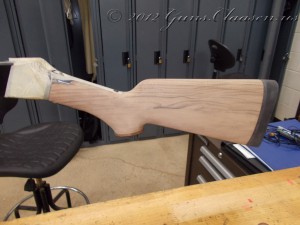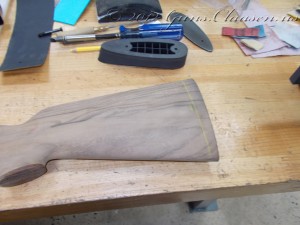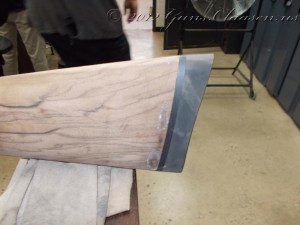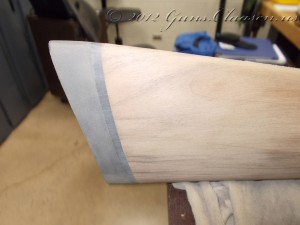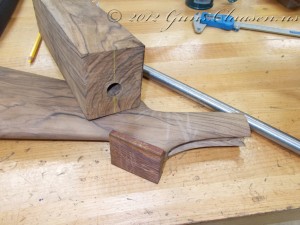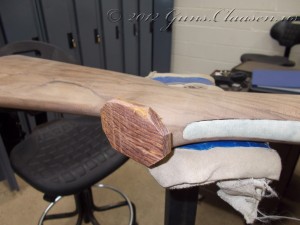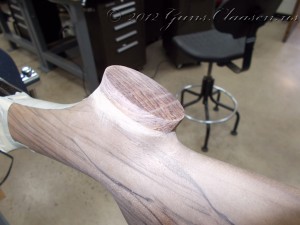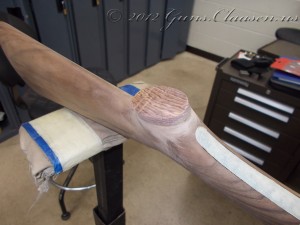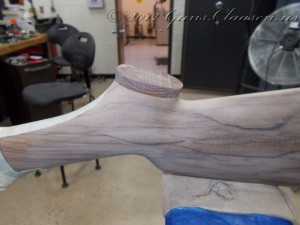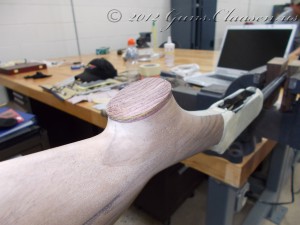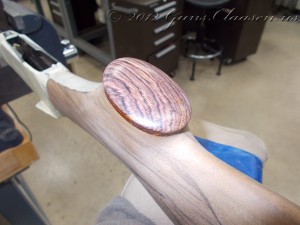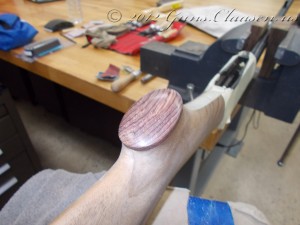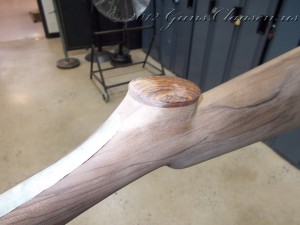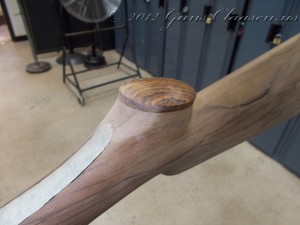Stockmaking
 Winchester 94: Stock wrap up
Winchester 94: Stock wrap up
In this next to the last post on the Winchester 94 stock project I will cover the issues I mentioned in my earlier post on this project. I will also show the almost completed stock and fore end. In the earlier post, I milled out the area between the upper and lower tang of the receiver to fit all the internals. Although I did protect the wood from the clamp on the milling machine, it did suffer a little and I was left with a few small dents in the wood. Luckily, they were not very deep and I did manage to steam them out. If you look at the full size pictures, you will also note that you can still see some pores in the wood. At this stage, the stock and fore end only have a few finish coats on them.
The next few pictures show the stock and the fore end close to what they are looking like now. Although it is difficult to see, there is still a few places where the wood pores show through.
I will do one more post on this project. I have gotten it very close to the point where I am totally satisfied with it. I still have a few small pores in the fore end which I hope will no longer be there after the next finish coat. Once I am happy, I will re-assemble, take a few close-ups and post those for everyone to see.
 Winchester 94: Stock finishing
Winchester 94: Stock finishing
The stock on the Winchester is now on the last few steps. To obtain a grade, we have to do at least one finish coat on the wood. During grading the instructor looks and makes sure that there is no scratch or tool marks in the wood. The finish I used for this stock is Custom Oil by Gun Sav’R. I chose to use a satin finish. The finish is available in an aerosol and liquid that can be sprayed by airbrush or paint gun. I used both, starting with an application of liquid rubbed into the stock.
Once I got to this point I realized I had forgotten something quite important. I had not removed all the wood in the buttstock and the action would not fit at this point. For reasons I will show you in the next post, I will make sure I do this earlier in the finishing process next time. So, of to the mill, to clamp and mill out most of the material that is in the way. It is a little tricky to clamp this and I had to take care to make sure everything was lined up correctly.
After I completed the milling work (with a little filing as well) I started to assemble the rifle to ensure proper operation. I cleaned all the parts first and then assembled. Since it had been a long time since I disassembled the rifle, I did not go together on the first try but that is how you learn!
The next few pictures speak for themselves. When you work with wood, it is always difficult to predict exactly what it will look like as you shape the wood. An interesting pattern on the outside could just fade away as you start removing wood. That did not turn out to be the case on the forend. The slight discoloration between the forend and the receiver is some Acraglas. This time, I did color it a little darker.
I am happy with the way this project is shaping up. The barrel band fit is not perfect and there is a few dimension not quite the way they should be, but those are not very noticeable. The forend feels and fits really well in my hand. I should have one more post on this project where I will be able to wrap up.
Thank you again for stopping in and reading!
 Winchester 94: Bedding the stock
Winchester 94: Bedding the stock
Getting close to the end of this project (in posts, not time). I am now ready to glass bed the stock into the action. On this rifle, it will help with cosmetics as it will let everything fit together nicely. The glass bedding will also protect the wood from cleaning solvents and gun oils in the areas under the metal. Here we can see the stock ready for application.
Although it can not be seen in the picture all the metal parts are now coated with a mold release agent. This will prevent the metal adhering to the glass bedding. If you do not use a release agent, all you are creating is an expensive club as it will be very difficult to remove the stock from the action without destroying something.
The next step is mixing the glass bedding material. I am using Brownells Acraglas Gel® for this project. Basically it is a two-part epoxy with a small amount of dye added to color match the wood.
Once the Acraglas is mixed, it is applied to the stock, the receiver inserted and tightened as it would normally be. At this point, there is no internal parts in the receiver. In order to make sure there is space for all the parts and to prevent the bedding material from going into place I do not want it to go, I used play-do as a filler. That is the green stuff you see. Who says a gunsmith can not have fun!
After the Acraglas hardened for a while, I removed the receiver from the stock to verify it can come out of the stock.
I also removed as much of the play-do that I could at this time. The receiver was then coated with a release agent again, re-assembled and left to cure overnight.
After the Acraglass cured, I removed all over spatter and streaks from the wood.
The stock is now ready the first finish coat. (Or so I thought) In the next post I will show the start of the finishing process.
 Winchester 94: Recoil pad
Winchester 94: Recoil pad
Okay, I must admit that I should have done this a little earlier. At this point I had already started sanding the stock and ideally, the recoil pad should be installed already when you start this. The recoil pad is ground down to the size of the stock on a belt sander and it is very easy to make a mistake and remove a bit too much material. The first step in fitting the pad was to measure the length of pull for the stock. When you buy a mass-produced rifle the butt stock is the size the manufacturer decides on. On a custom gun stock, this can be made to the owners preference. You can see the recoil pad in the background of the picture.
I cut the stock to size and then marked the center line and the position of the two mounting screws.
At this point, I wrapped the back of the stock with equal layers of masking tape. The masking tape will offer protection for the wood that is already sanded and give me a visual indication of when I start touching the wood with the sander. Unfortunately I got so engrossed in my work at this point and totally forgot to take any further pictures until after I finished! Here is the finished product though. In the first picture you can still see a little adhesive residue from the tape.
In the next post, I will bed the stock to the action.
 Winchester 94: grip cap
Winchester 94: grip cap
The grip cap is now glued to the rest of the butt stock and I can start shaping it to blend in with the butt stock. The first picture gives you an idea of my progress at the time on the fore end.
As always, the first step is rough shaping.
With the grip cap blended to the butt stock, I thought it was still a little too thick and made it a little thinner.
With the grip cap now at the desired thickness, I started smoothing all the sharp edges on it. I also polished a little to get some idea of what it will look like once I complete the stock.
When I looked at the grip cap, I was not happy with the way the grip cap flowed into the front end of the butt stock. It was not really something I could photograph, but I reshaped the front area a little and though it looked better.
In my next post in this series, I will outline the process of fitting a recoil pad to the butt stock.
